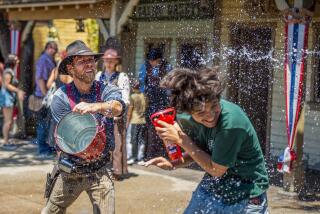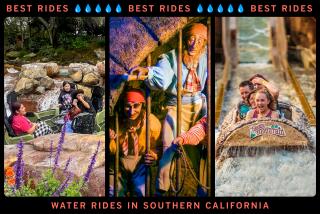VARIATIONS ON A THEME : Knott’s Berry Farm unveils a make-over and new ride in the park’s effort to face down larger competitors
Like its lovable signature character Charlie Brown, Knott’s Berry Farm in Buena Park has long been the plucky underdog among area theme parks.
Living in the shadow of Disneyland and lacking the star-studded sizzle of Universal Studios Hollywood, Knott’s has continued to draw crowds over the years with a folksy combination of boysenberries, beagles and buckaroos.
“It’s a slower pace, a nice alternative,” observed Jim Benedick, leisure industry consultant with Management Resources in Tustin. “There’s a real nostalgic quality about it.”
But the line between nostalgic and arthritic has narrowed considerably in recent years in an industry obsessed with state-of-the-art, megabucks attractions such as Disneyland’s Indiana Jones adventure ride and Universal’s upcoming Jurassic Park extravaganza.
Suddenly, Knott’s stiff Ghost Town mannequins and plaster volcano are looking a bit shopworn.
Buffeted by recession and lacking the fat capital budgets of its corporate rivals, the privately held Knott’s Berry Farm has seen attendance figures shrink by nearly a third over the last five years, according to industry estimates.
Although the park doesn’t disclose visitor totals, Amusement Business magazine estimates that Knott’s attracted 3.4 million paying guests in 1995, down from 5 million in 1990.
“It’s tough to compete on a money level with the big guys,” said Harrison (Buzz) Price, a San Pedro-based theme park consultant who has done strategic planning for the family-owned park. “You’ve got to find another way.”
Knott’s offered a glimpse of its strategy last week with the announcement of the Boardwalk, a beach-themed make-over of the flagging Roaring 20s area of the park, to be unveiled this summer.
In addition to new restaurants, games, shows and characters, the Boardwalk will be anchored by HammerHead, a shark-themed spin ride intended to boost Knott’s standing among the thrill-seeking set.
But in an industry now dominated by corporate giants, in a county where Disneyland is poised to unveil a multimillion-dollar expansion, and at a time when consumers are addicted to increasingly expensive high-tech wizardry, some wonder if Knott’s can build an arsenal to take on the big guns.
“A pop gun in the theme park arms race,” one industry observer sniffed at the low-tech HammerHead, an updated version of the old European RotoShake. “I’d be surprised if that brings people running back.”
*
Speculation has surfaced in recent years that the Knott family, now in its third generation of ownership, has taken the theme park as far as it can go as a private entity.
Last year the family shocked the industry by selling off its food division, producer of founder Cordelia Knott’s beloved jellies and jams. Some industry watchers predict the eventual sale of the park as well.
Knott family members and President and CEO Terry Van Gorder declined to discuss the park’s future and competitive strategy. But others note that the family has defied conventional wisdom from the start, launching what would become a chicken-dinner dynasty out in a berry patch in the depths of the Great Depression.
Knott’s still serves what many say is the best food in the business. Its admission prices are lower than rivals’. Its Peanuts characters remain popular, and Knott’s is located just 10 minutes from Disneyland--a decided strength, not a weakness, for a second-tier attraction that thrives on overflow from the Anaheim park, said analyst Steve Balgrosky of Economics Research Associates in Los Angeles.
“Maybe Knott’s will remain the contradiction” to the trend toward corporate ownership and blockbuster attractions, Balgrosky said. “They’ve got a unique product and they’ve been at it a long time.”
Critical to Knott’s future success is the issue of identity. Other parks have geared their marketing to instant recognition. Disneyland has the mouse. At Universal, you ride the movies. Sea World is jumping fish and Magic Mountain is roller-coaster Valhalla.
But quirky Knott’s defies easy definition in an age of sound bites and brand names.
“They are suffering from something of an identity crisis,” said Thor Degelmann, a theme park consultant and principal with Newport Beach-based Leisure Entertainment Development & Operations International. “They need to get back to a coherent theme.”
*
But that eclectic jumble is part and parcel of the Knott’s legend. Unlike other theme parks that were planned from the ground up, Knott’s evolved over time from a working farm to an entertainment mecca in a strategy driven as much by appetite as imagination.
It all began with fried chicken. Cordelia Knott began dishing up meals to hungry travelers back in 1934 on the family farm that is now the site of the 150-acre park. Customers raved, lines formed.
By the 1940s, husband Walter, something of a history buff, cobbled together an Old West ghost town on the site as a diversion for the milling patrons. The family kept adding to the display and launched it as a full-fledged theme park in 1968.
The original Ghost Town still remains, but the park moved beyond the Western theme to accommodate changing visitor tastes, according to Knott’s spokesman Bob Ochsner.
Over the years, Knott’s added a Southwestern marketplace area, water rides, live entertainment and dolphin shows. It turned to roller coasters in the late ‘60s and ‘70s, then to a Peanuts-themed children’s area called Camp Snoopy in the 1980s.
Ochsner said the mix is designed to appeal to a broad spectrum of theme park visitors of all ages. But industry watchers said Knott’s has veered in any number of directions, attempting to copy successful attractions at other parks without developing a cohesive vision of its own.
Some areas have become little more than a hodgepodge, stretching the concept of “theming” to the breaking point. Witness the dinosaur ride tucked inside the Roaring 20s section.
“They don’t appear to have come to grips with being one thing or another,” said industry analyst Dick Lyon of Pacific Palisades. “It’s as if they don’t know what course to follow.”
*
The new Boardwalk concept could be a welcome boost to the fraying, schizophrenic Roaring 20s melange, long in need of a face-lift. But other recent introductions have met with mixed reviews from patrons and analysts.
In 1994, the park unveiled Mystery Lodge, a special-effects theatrical attraction with a Native American theme. A pet project of Knott’s Van Gorder, the attraction was admired for its sensitivity to America’s indigenous people.
Knott’s said the attraction boosted attendance 10%, but industry sources said it hasn’t translated into sustained excitement among visitors.
“It’s very pleasant, but it hasn’t generated the kind of crowds they’d hoped,” said a source close to Knott’s. “It’s the kind of thing people walk out of and never think about again.”
Last year’s introduction of the Jaguar roller coaster has also brought mixed reaction.
Cleverly designed to make maximum use of the park’s limited space, the Mayan-themed coaster winds around and through other attractions in a series of banking turns and quick dips. But it lacks the white-knuckle speed and whiplash loops demanded by true coaster aficionados.
“Lame,” declared Laurie, a gum-chewing 11-year-old from Orange, summarizing her trip on the Jaguar one recent afternoon. “It wasn’t worth waiting 30 minutes for.”
Industry watchers said behemoths like Disney and Universal, which can drop $100 million on a single ride, have raised consumer expectations for what a new attraction should be. That makes it tough for small players like Knott’s to impress crowds.
But consultant Price said that’s not the only way to compete.
“People get tired of being shaken in a simulator,” Price said. “The key is to be nimble, flexible and carve out a niche.”
*
To that end, Knott’s has focused on special events, young children’s attractions and corporate group sales--areas often overlooked by bigger competitors.
The Knott’s Scary Farm Halloween celebration has become a sellout each October, while Knott’s hosts more company picnic business than any theme park in the country.
A forerunner to Disney’s Toon Town, the Camp Snoopy children’s area has proven a successful formula for Knott’s. The company expanded the concept in 1992 by putting an indoor version inside the Mall of America near Minneapolis, and it’s scouting other potential locations around the country, according to spokesman Ochsner.
Likewise, Knott’s merchandising has made great strides since hooking up with the Peanuts gang in a licensing agreement in the early ‘80s. Characters are king at theme parks, and Snoopy and friends have helped raise Knott’s profile among national and international visitors in addition to boosting revenue, said Karen Yoshikawa, former general manager and vice president of merchandising for Knott’s.
“When they partnered with [Peanuts creator Charles] Schulz, it opened up a whole new avenue of merchandising for Knott’s,” Yoshikawa said. “It has done really, really well for them.”
Still, Knott’s lacks the big promotional budget and product tie-ins available to media giants such as Disney, Universal and Paramount, which use their movies and videos to promote their theme parks and vice versa.
“The cross-marketing potential available to media and film companies is just enormous,” analyst Balgrosky said. “Peanuts are fine characters for Knott’s, but they don’t provide the same benefits, the same synergy.”
With more than three-quarters of theme park attendance now controlled by the Big 5--Walt Disney Co., MCA Inc., Time Warner, Paramount Communications Inc. and Anheuser-Busch Co.--some speculate it’s just a matter of time before the Knott family cashes in and sells out to a corporate owner.
That opinion was bolstered last year by the family’s surprise sale of its food business to Omaha-based ConAgra Inc. for an undisclosed sum. The move, following a brutal round of company layoffs in 1993, has convinced some longtime Knott’s employees that the park will eventually pass to outsiders.
“If they’ll sell Mrs. Knott’s jam, they’ll sell the park,” a retiree said. “The unthinkable is now thinkable.”
But others said the third generation of the Knott family has shown considerable interest in running the operation.
Analyst Price said nothing is inevitable in a peculiar business founded on chicken grease and pluck. And in an industry dominated by media giants and high-speed pyrotechnics, he said, there’s always room for an alternative.
“People love that park because it’s not Disney,” Price said. “Don’t ever count the little guy out.”
(BEGIN TEXT OF INFOBOX / INFOGRAPHIC)
Knott’s Knocks
Knott’s Berry Farm attendance has been on a roller-coaster ride in the last decade, rising with the California tourist boom of the 1980s and dropping because of the recession and increased competition in the ‘90s. Attendance, in millions, and the park’s ranking among the top 50 North American amusement and theme parks: *--*
Year Attendance Rank 1985 3.5 3 1986 3.5 5 1987 4.0 5 1988 4.0 6 1989 5.0 4 1990 5.0 3 1991 4.0 5 1992 3.9 7 1993 3.7 9 1994 3.8 8 1995 3.4 13
*--*
Source: Amusement Business Researched by MARLA DICKERSON / Los Angeles Times
More to Read
The biggest entertainment stories
Get our big stories about Hollywood, film, television, music, arts, culture and more right in your inbox as soon as they publish.
You may occasionally receive promotional content from the Los Angeles Times.










